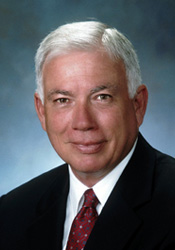Money Isn’t the Only Thing
 Jim Nelson
Jim Nelson  Wednesday, April 6, 2011 at 6:50AM
Wednesday, April 6, 2011 at 6:50AM  By Jim Nelson, Executive Director, AVID Center
By Jim Nelson, Executive Director, AVID Center
Last week, The New York Times ran a series addressing the long-time issue of raising the status of teachers. Several credible bloggers weighed in, giving suggestions ranging from allowing teachers more autonomy to embedding more accountability. My good friend Kati Haycock, President of the Education Trust in Washington D.C., proposed that we “improve teacher training,” and she couldn’t be more accurate. My experience as state commissioner in Texas, as a superintendent, and as AVID’s executive director has allowed me to observe classrooms across the country, and the one constant to student success is a highly qualified teacher.
Intent on reaching AVID’s mission of “closing the achievement gap by preparing all students for college readiness and success in a global society,” we have been tireless in our passionate pursuit of excellent professional development for educators. We know that to reach the student, we must first reach the teacher and provide him or her with tools that will help students develop lifelong habits and academic behaviors that will guarantee they are ready for college and a career. If you want to learn more about the research on college and career readiness, see our interview with Dr. David Conley.
Developing great teachers is especially on my mind right now as we prepare for our 2011 Summer Institutes, where we will train nearly 20,000 educators. This week, we will gather “the best of the best”— more than 300 AVID staff developers who will work with educators throughout the summer to fulfill AVID’s mission. In over 30 years of training teachers, we have learned a great deal about educational pedagogy and strategies that motivate and inspire teachers. We also continue to learn ourselves and bring new methodologies into our training based on experience and solid research (both internal and external). In line with research, we are beginning to incorporate a blended learning approach, combining e-learning with the face-to-face training that has been our hallmark. This method will make our training even more meaningful for our participants.
I have the deepest regard for Kati Haycock and agree that teachers should be fairly compensated, but I know that extrinsic rewards, like monetary compensation, only go so far. Shawn Achor in his recent book, The Happiness Advantage, refers to research by Dr. Amy Wrzesniewski, a Yale psychologist, and her findings. She says, “employees have one of three “work orientations,” or mindsets…. We view our work as a Job, a Career, or a Calling. People with a calling view work as an end in itself; their work is fulfilling not because of external rewards, but because they feel it contributes to the greater good, draws on their personal strengths, and gives them meaning and purpose.”
I believe most people would agree with me when I say the education profession is a calling. What is more fulfilling for an educator than helping students succeed?
Here’s where the AVID system helps teachers thrive. AVID site teams, (school teachers, counselors, and administrators) work together to build student success over several years. Even with a segmented K-12 system where elementary and middle school teachers usually don’t get to see the “endgame” of college, student data collection allows AVID site teams to see tangible qualitative and quantitative results as their AVID students graduate, thus helping teachers feel they are making a real difference. Within the AVID system, elementary teachers see their students going into middle school with college ready skills; middle school teachers see their AVID students enrolling in more advanced and rigorous classes, and high school teachers watch their AVID students succeed in those rigorous courses, apply, and then gain acceptance into colleges and universities. It’s these achievements that motivate teachers as much or more than any extrinsic financial reward I’ve seen. And, as AVID moves into work with postsecondary institutions, I am excited about the opportunity to work with teacher education programs to improve the quality of our teaching workforce, to impact even more students.
Our data bears out over and over that AVID trainings can and do produce excellent teachers. We’re in the business of making good teachers better and better teachers great. After our trainings, when teachers return to the classroom and apply our strategies with fidelity, high student achievement follows quite naturally, even predictably. For example, for the past five years, AVID students complete four-year college requirements at more than double the national average!
As Kati Haycock says, “Nothing is more important to our country’s future than closing the longstanding gaps that separate low-income and minority children from other young Americans and ensuring that all students are prepared for life after high school.” We agree, and our professional development makes it happen for more than 400,000 students each year. I can’t wait to connect with over 300 of our country’s best educators as we prepare for the 2011 Summer Institutes!
Reader Comments